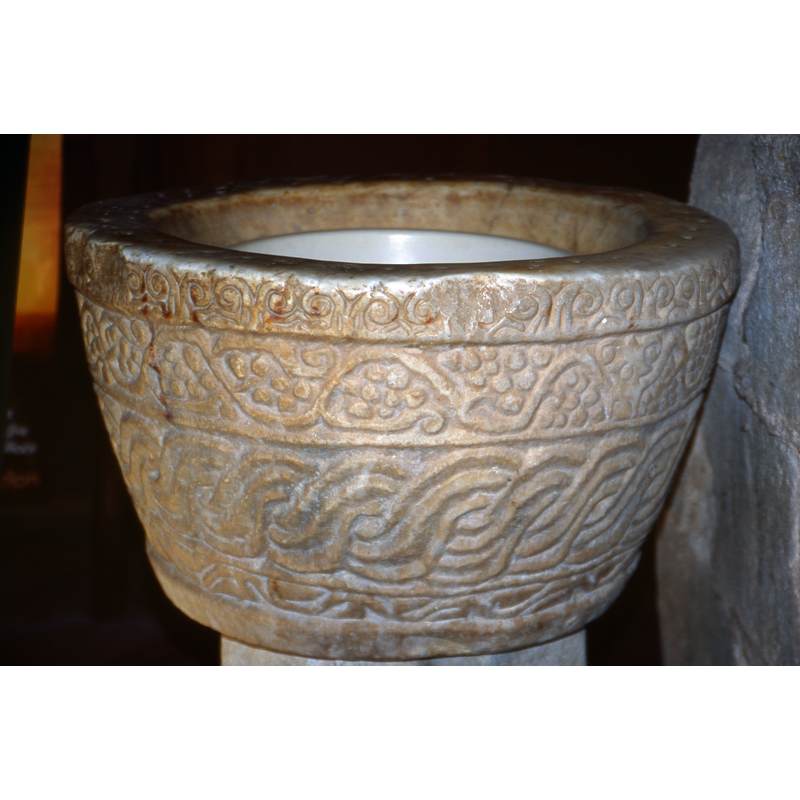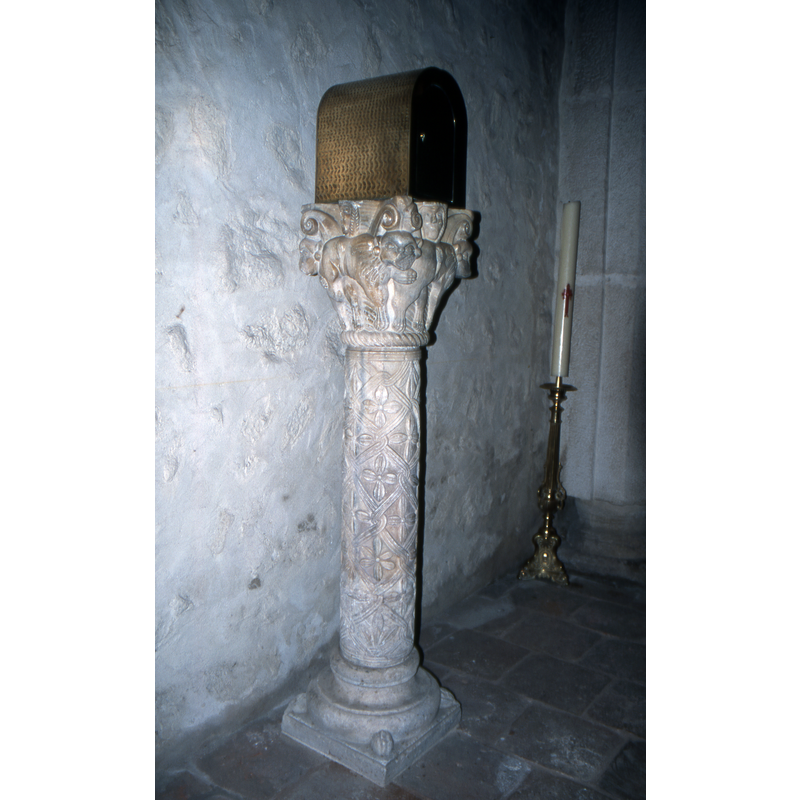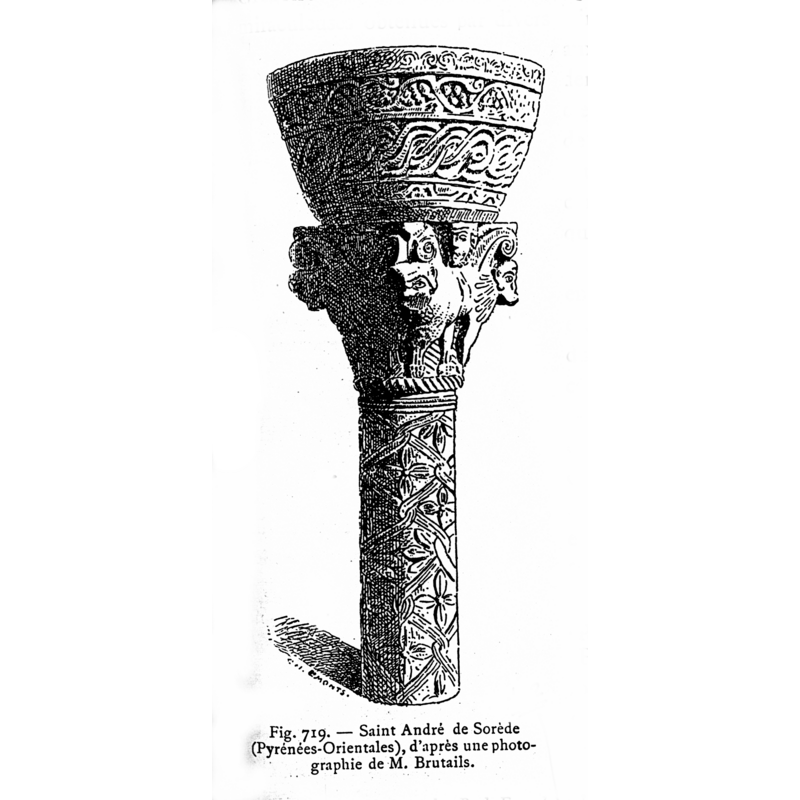Saint-Andre-de-Sorede No. 2 / Saint-André-de-Sorède / Sant Andreu de Sureda

Results: 12 records
design element - motifs - braid - 3-strand
design element - motifs - vine - grapevine - bearing fruit
design element - motifs - wave - with inserts
design element - patterns - scroll
information
view of base
view of base - detail
view of base - detail
view of base in context
view of font - upper view
view of stoup
INFORMATION
FontID: 03920SOR
Object Type: Stoup
Church/Chapel: Eglise paroissiale [ancienne abbatiale] Saint-André / Església Sant Andreu
Church Patron Saints: St. Andrew
Church Location: 1 place de l'Église, 66690 Saint-André, France
Country Name: France
Location: Pyrénées-Orientales, Occitanie
Directions to Site: Located off (S) the D11-D618 crossroads, 3-4 km W of Argelès-sur-Mer, 10 km S of Elne, about 18 kms ENE de Céret
Ecclesiastic Region: Diocèse de Perpignan
Historical Region: Languedoc-Roussillon
Font Location in Church: South side of the west door
Century and Period: 9th - 12th century, Romanesque
Church Notes: The Dictionnaire des églises... (1966-) informs that this church belonged originally to a Carolingian monastery [the beautiful altar mensa may be that early - cf. Images section]; it was restored in 1109 and re-consecrated in 1121, but retained an important part of the old building. The same source mentions the lintel of the portal [cf. Images section] as being in the style of that at Saint-Genis-des-Fontaines, but executed by a different master.
Font Notes:
Click to view
Described in Delcor (1993) as a composite stoup: it has a bucket-shaped basin mounted on a shaft and a capital [cf. below for dating details]; the sides of the basin, suggests Delcor (ibid.), appear "plutôt tapisée de gravures que sculpté": two registers, the upper with a "torsade" motif, and the lower with a grapevine. He states that this holy-water stoup had been dated by Brutails (1901) as being of the 12th century, but himself sees the object as composite, the base and stem of the base being, as Brutails had said, of the 12th century, and tracing its style to the cloister at Elne; the basin, however, argues Delcor -and he refers to Lasteyrie (1929) for support- has a style more in line with works of the 8th and 9th centuries (Delcor, 1973, p. 100-101). Marcel Durliat, in his entry in the Dictionnaire des églises... (1966-) mentions simply a very old stoup raised on a Romanesque capital as base. In his Roussillon roman (1975) Durliat describes the ornamentation on this stoup as "sculpté en méplat par un ciseau peu expérimenté." Lasteyrie (1929) himself argues for an early date, 8th or early 9th century, and explains that the later dating by Brutails must have been influenced by the capital and stem of the base, both of which have ornamentation related to nearby Elne; the basin, however, poses Lasteyrie, is of a much earlier date ["la vasque elle-même est certainement beaucoup plus ancienne"]. Described and illustrated in Catalunya romànica (1984- , vol. XIV: 356-357). Ponsich (1980) identifies the upper the lower band as ivy and the upper one as a grapevine. On-site notes: the stoup as it stands now [June 2001] no longer matches any of the above descriptions because the basin stands now on an ugly and plain octagonal pedestal which looks like recent concrete. The beautiful base described in Delcor, Lasteyrie, et al., a slender column and a lovely Romanesque capital, serves now as the stand for the "tabernacle" in the apse, to the left of the altar [cf. Images section]. The sides of the marble basin have four horizontal rows of ornamentation: the upper one, at rim level, is made of small scrolls; the next row down, is a grapevine; the third down is a wide braid and the fourth is a wavy line pattern.
COORDINATES
Church Latitude & Longitude Decimal: 42.5525, 2.9711
Church Latitude & Longitude DMS: 42° 33′ 9″ N, 2° 58′ 15.96″ E
UTM: 31T 497627 4711123
MEDIUM AND MEASUREMENTS
Material: stone, marble (basin only)
Number of Pieces: two
Font Shape: bucket-shaped (mounted)
Basin Interior Shape: round
Basin Exterior Shape: round
Drainage Notes: the basin well now has a ceramic insert
Rim Thickness: 7.5 cm
Diameter (inside rim): 43 cm
Diameter (includes rim): 59 cm
Basin Depth: 22 cm
Basin Total Height: 33 cm
Height of Base: 36 cm [NB: this is the modern pedestal]
Font Height (less Plinth): 69 cm
Notes on Measurements: BSI on-site [NB: the measurements correspond to the stoup as it stood in June 2001]
REFERENCES
Catalunya romànica 13: el Rosselló, el Vallespir, la Fenolleda, Barcelona: Pòrtic, 2001
Dictionnaire des églises de France, Belgique, Luxembourg, Suisse, Paris: R. Laffont, 1966-
Brutails, Jean Auguste, Art religiós en el Rosselló, Barcelona: L'Avenac, 1901
Delcor, M., "Cuves romanes et leur figuration en Roussillon, Cerdagne et Conflent", 1973, no. 4, Cahiers de Saint-Michel de Cuxa, 1973, pp. 96-109; p. 100-101
Durliat, Marcel, Roussillon roman, La Pierre-qui-vire, Yonne: Zodiaque, 1986
Enlart, Camille, Les monuments des croisés dans le royaume de Jérusalem: architecture religieuse et civile, Paris: Librarie orientaliste Paul Geuthner, 1925-1928
Fundació Enciclopèdia Catalana, Catalunya romànica, Barcelona: Fundació Enciclopèdia Catalana, 1984-
Lasteyrie du Saillant, Robert Charles, conte de, Architecture réligieuse en France à l'époque romane (2e éd., avec une bibliographie critique par Marcel Aubert), Paris: A. Picard, 1929
Ponsich, P., "Les plus anciennes sculptures médiévales du Roussillon (5-11 siécle)", 11, Cahiers Saint-Michel-de-Cuxa, 1980, pp. 293-331, 33 fig.; p. 304
Puig i Cadafalch, Josep, Escultura romànica a Catalunya, Barcelona: Alpha, 1949







